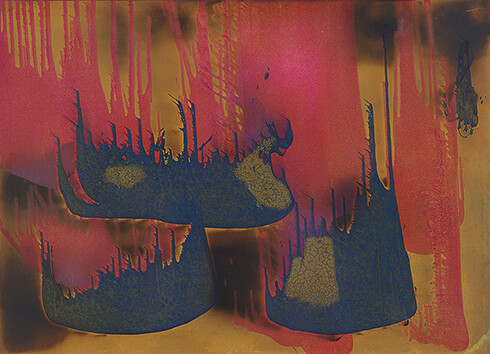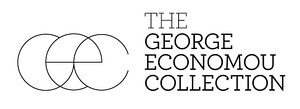October 13, 2016–April 9, 2017
80, Kifissias Ave.
151 25 Marousi
Greece
Hours: Monday–Friday 10am–6pm,
Wednesday 10am–8pm
T +30 21 0809 0559
info@economoucollection.com
Alberto Burri / Chung Chang-Sup / Chung Sang-Hwa / Lucio Fontana / Ha Chong-Hyun / Yves Klein / Kwon Young-Woo / Heinz Mack / Sadamasa Motonaga / Saburo Murakami / Yuko Nasaka / Park Seo-Bo / Gianni Piacentino / Salvatore Scarpitta / Jan Schoonhoven / Kazuo Shiraga / Günther Uecker / Chiyu Uemae / Yun Hyong-Keun
Curated by Frances Morris
The George Economou Collection is pleased to announce New Beginnings: Between Gesture and Geometry, an exhibition bringing together work by 19 artists who emerged in the years following World War II. Looking beyond the canonical Paris–New York axis, the show focuses on the geographically more dispersed but no less ground breaking practices of artists in Europe and Asia whose radical innovations were the result of dialogue and exchange among a rich network of individuals and groups that transcended national borders.
After World War II, many artists felt that figuration had become impossible and turned to physical gestures and material processes as well as the immaterial qualities of light, space and movement to create a new and dynamic relationship with the viewer. Alberto Burri, Lucio Fontana and Yves Klein were all, in different ways, enormously important in liberating painting from its conventional pictorial role—bringing time, space and matter into the frame and thus into the consciousness of the audience. For many artists their example provided an important catalyst.
In Japan, a younger generation were exploring similar ideas and founded the Gutai Art Association in Osaka in 1954. Aware of developments in American painting, these artists deliberately sought to extend the potential of the medium through innovative techniques and unconventional materials. Kazuo Shiraga, for example, invented a technique of painting with his feet, while other artists incorporated non-artistic materials such as pebbles, cloth and sawdust into their work. Gutai was introduced to Western artists and audiences via their internationally distributed journal and through the intervention of the French critic and gallerist Michel Tapié, who began showing their work in Turin in the late 1950s.
Another related and almost simultaneous break with the past was initiated by the group Zero, founded in Düsseldorf three years after Gutai. Zero was a network of artists from across Western Europe with connections to Latin America and Japan as well as informal links to other groups in Europe such as the Dutch Nul group. Artists including Jan Schoonhoven and Heinz Mack rejected the language of gestural painting, proposing in its place a refined vocabulary of geometrically organised forms and a preference for the monochrome. This is echoed in the work of Korean artists associated with the Dansaekhwa movement and their own explorations, starting in the 1970s, of the materiality of non-figurative abstraction.
The works in New Beginnings are remarkable not only for their formal and conceptual innovations, but in how they trace the outlines of a global art world that has been too often overlooked in favour of a New York–centric art history. The belief shared by many of the artists that international exchange could be a vehicle of progressive innovation offers a new perspective on the history of postwar art and offers a fascinating model for intercultural collaboration and dialogue today.
Frances Morris is Director of Tate Modern. She joined Tate as a curator in 1987, becoming Head of Displays at Tate Modern (2000–06) and then Director of Collections, International Art until April 2016 when she was appointed to her current role. She has continually worked to re-imagine Tate’s collection and has been instrumental in developing its international reach and its representation of women artists. Morris was jointly responsible for the initial presentation of the opening collection displays at Tate Modern in 2000, which radically transformed the way museums present the story of modern art. She has curated landmark exhibitions, many of which were large-scale international collaborations, including three major retrospectives of women artists: Louise Bourgeois in 2007, Yayoi Kusama in 2012 and Agnes Martin in 2015.
Earlier in her career, Morris curated Paris Post War: Art and Existentialism in 1993 and in 1995 she worked with Stuart Morgan on the exhibition Rites of Passage. Specialising in post-war European and contemporary international art, she has published widely on the subject and has also curated projects with many contemporary artists from Britain and abroad, including Miroslaw Balka, Chris Burden, Geneviève Cadieux, Sophie Calle, Mark Dion, Luciano Fabro, Paul McCarthy and Nicholas Pope.
Morris holds a BA in History of Art from Cambridge University and an MA in History of Art from the Courtauld Institute of Art, London. She is a board member at Fruitmarket Gallery, Edinburgh, a board member of CIMAM and a member of the Advisory Committee of the Serralves Museum of Contemporary Art in Porto.
For further information or images, please contact Caroline May on T +30 210 8090566 or caroline [at] artesia.gr


